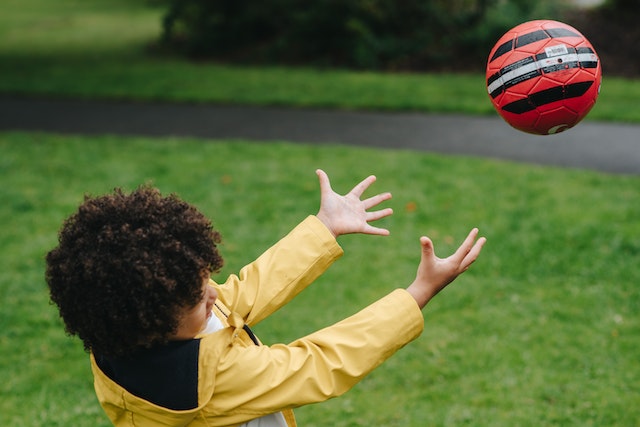
How can we catch a ball without looking at it? It is a combination of proprioception and the brain’s ability to predict.
What is proprioception? It is the ability to sense your own body position. It is often called the sixth sense. All of our muscles, joints, and tendons have sensory receptors in them. When we move, these receptors send messages to the brain telling it what has moved and where it is. Your brain cross references this information with the vision system, the nervous system, and the balance system to work out what position your body is and where all of its parts are. The brain is constantly aware of every part of the body. A mismatch between these signals is what causes problems like seasickness. The main use of proprioception is simply standing up. When we are standing, or when we are walking, our bodies constantly have to adjust our muscles to keep us balanced. The brain is constantly making minor adjustments to our muscles to make sure we stay level when we are just standing and to make sure we don’t fall over if we are walking on an uneven floor. Without proprioception, you would have to look at your feet while you walked.
How do we catch a ball? There are two different methods for two different types of catches. The first would be a long catch. Let’s say you are playing baseball and the batter has just whacked the ball high into the air. This is the 9th inning, your team are one up, there are two outs, but the bases are loaded. The ball is heading in your direction. Catch it, and your team will win the championship. Miss it and your team will never let you forget it. How do you get yourself to be in the right place to catch the ball. When the ball is hit, the fielder will watch the ball’s trajectory. We are able to judge the speed and the angle of an object in flight by using visual signals to measure the object’s size. Our brain constantly refreshes the signal and tells us if the item is getting larger or smaller, and how quickly it is getting larger or smaller. We can use this information to know how fast the ball is going, and our brain uses it to predict the path of the object and to put us in the right place to catch the ball. Whether or not we catch it is a different problem to getting us in the right place. Practice can make someone a lot better at catching things.
The second type of catch is if something is thrown directly at you, and you don’t have the luxury of watching it sail up into the air. In this case, the brain works in the same way as before, but it has to work faster and predict more accurately. Our brain judges speed in the same way by working out how quickly the size of the object is changing. Once the brain has calculated the speed, it has to predict where the ball will land. This is where the brain is amazing. It takes about 0.28 seconds for us to see something and then react to it. Because the brain is aware of this delay, it predicts where the object will be approximately 0.28 seconds from where it is at the time we see it and moves the hand to intercept the object. Experiments performed in space show that we take gravity into account as well. We use our knowledge to predict how the ball will move and at what speed. Astronauts in space were always too early to catch a ball because they expected it to move with Earth’s gravity. That would make sense because we have learned how to catch on a planet with gravity and our mental system has developed to match that.
So, how do we catch a ball without looking at it? Well, the first thing to be aware of is that we might not consciously be looking at the ball, but our brain is aware of the visual signal. We may focus on one thing, but our eyes are constantly moving around with minuscule movements called microsaccades. If a ball is thrown at us while we are looking at something else, but our eyes still see it (you are not going to be able to catch something thrown at the back of your head), then the brain will calculate the trajectory. The brain will know exactly where your hands are because of proprioception, and it will move the closest hand to where it predicts the object will be. The brain’s main goal is to defend you from something flying at you, so all it wants to do is get your hand in the way of the object. You may or may not catch the object. The more you practice, the more likely it is you will catch the object. However, another thing to be aware of is confirmation bias. We remember that one time someone threw a bag at us and we caught it even without looking, but we forget the other 29 times that the bag just hit us in the head. And this is what I learned today.
Photo by Anete Lusina from Pexels: https://www.pexels.com/photo/careful-black-boy-catching-ball-5240424/
Sources
https://www.ncbi.nlm.nih.gov/pmc/articles/PMC7329307/
https://elifesciences.org/articles/85301
https://www.webmd.com/brain/what-is-proprioception
https://en.wikipedia.org/wiki/Proprioception
https://www.upi.com/Archives/1983/01/28/The-physics-of-judging-a-fly-ball/2171412578000/
https://www.wired.com/story/how-do-people-actually-catch-baseballs/
https://science.nasa.gov/science-news/science-at-nasa/2002/18mar_playingcatch
https://www.sciencedaily.com/releases/2022/03/220325185902.htm
